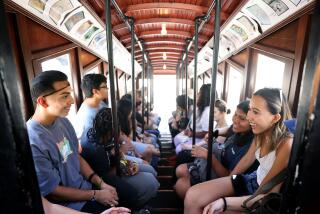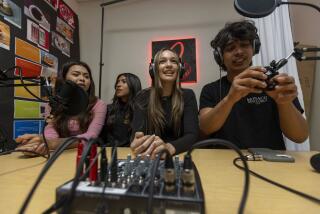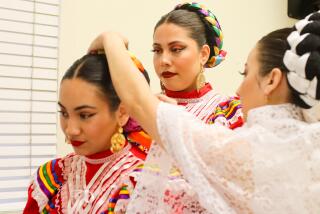LA HABRA : Student Project Is Cultural Experience
Isabel Nungaray learned a valuable lesson Wednesday as she helped complete a quilt as part of a classroom assignment promoting cultural understanding.
The 14-year-old La Habra High School student contributed a square of material, displaying Mexican, Hungarian, Spanish, Italian and American flags and other symbols that reveal her heritage.
Nungaray was among 103 ninth-graders who put together two twin bed-size quilts as part of their first lesson in cultural sensitivity. The students were required to research their roots and draw, paint, sew or glue symbols on 11-by-11-inch pieces of cloth to represent who they are.
Students said the two-week project taught them about their own heritage and instilled appreciation for other cultures.
âWeâre all different in some ways, but weâre all the same,â Nungaray said.
Olga Oropeza, 14, said the assignment made her proud of her who she is. She said she traced her family tree back several generations and interviewed her grandmother and uncle to find out about her Mexican roots.
âAll cultures should come together,â said Sam Cunanan, 14. âThatâs why I put a Christmas tree in the middle of my square. Christmas is the only time when people get together and like each other, and I want people to be like that all the time.â
The students are enrolled in the Heritage of the Americas Program, a four-year college preparatory course covering literature, language, social sciences and fine arts of North and South America. Subjects studied in the program are viewed with a global approach, recognizing the historical and cultural contributions of many different ethnic groups.
Now in its third year, the unique program has been used as a model at other schools wanting to replicate it, said Ann Elms, assistant principal in charge of overseeing the program. San Pascual High School in San Diego copied the program and implemented it last year, she said.
Three years ago, La Habra High School received a state grant to plan and implement the program, Elms said. The grant--about $500,000--was used to buy textbooks and pay for teacher training.
Only 100 to 105 students are accepted into the heritage program each year, and they are 50% Latino and 50% Anglo, black, Asian and other ethnicities, Elms said. There are more Latino students in the program because more than half the schoolâs population is made up of Latinos, she said.
Teachers said they emphasize different points of view and incorporate ethnic music, art and field trips to cultural events in delivering English, history, geography and science lessons.
In addition, Spanish is taught at an accelerated pace, with an emphasis in conversation.
The program prepares students âfor the realities of Southern California,â said Frank Thompson, the 10th-grade heritage world history teacher. âKids start to understand here that people are people and value all our differences.â
Added Pat Walker, a heritage English teacher: âThereâs meaning behind this curriculum. We try to teach (the students) to see through the eyes of others.â
Arturo Diaz, 16, who enrolled in the program when it began, said heâs learned just that.
âIâve learned to respect my culture and other peopleâs cultures too,â the 11th-grader said. âIt was scary at first, but everyday you want to learn more about different cultures.â
Diaz said he remembers when his class sewed quilts in 1991. That assignment, he said, âmakes you stop and think about who you are and what you believe in and then, little by little, you find yourself and you become proud.â
More to Read
Sign up for Essential California
The most important California stories and recommendations in your inbox every morning.
You may occasionally receive promotional content from the Los Angeles Times.










